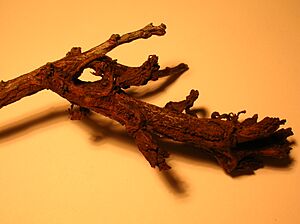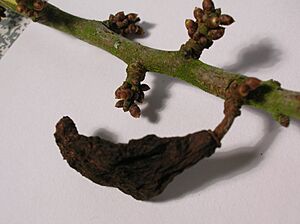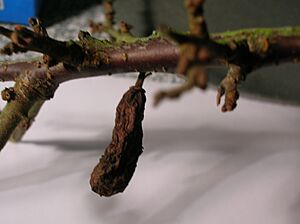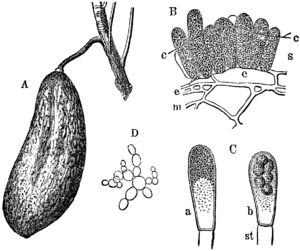Taphrina pruni facts for kids
Quick facts for kids Taphrina pruni |
|
|---|---|
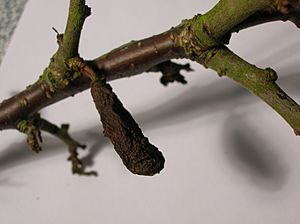 |
|
| Scientific classification | |
| Genus: |
Taphrina
|
| Species: |
pruni
|
| Synonyms | |
|
Ascomyces pruni (Tul.), W. Phillips, (1887) |
|
Taphrina pruni is a tiny fungus that attacks plants. It's a type of "plant pathogen," which means it causes diseases in plants. This fungus mainly affects blackthorn plants (Prunus spinosa). When it infects a blackthorn, it causes the fruit, called sloes, to grow in a strange way.
The fungus makes the sloes turn into something called a pocket or bladder plum gall. These galls are fruits that are swollen on one side, flat, and don't have a stone inside. The fungus also makes the twigs on infected plants look odd, with small, thin leaves.
Contents
What Plants Does Taphrina pruni Affect?
Taphrina pruni creates a unique, tongue-like growth on the fruit it infects. This growth is actually the fruit itself, changed by the fungus, not the fungus growing on top of it.
This fungus is similar to other types of Taphrina. For example, Taphrina alni affects alder trees, and Taphrina padi attacks bird cherry trees.
Besides blackthorn, Taphrina pruni can also be found on:
- Bird cherry (Prunus padus)
- Almond (Prunus amygdalus)
- Peach and nectarine (Prunus persica)
Some types of plums, like the Mirabelle or Greengage (which are varieties of Prunus domestica), might be more resistant to this fungus.
Where Can You Find This Fungus?
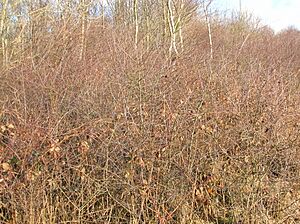
The pocket plum gall is found in many places around the world. It's common in the cooler parts of the Northern Hemisphere. In the United Kingdom, it's widespread but might not always be reported.
What Do the Galls Look Like?
How the Fruit Changes
The gall caused by Taphrina pruni is usually called 'pocket plum'. Other names include 'starved plum' or 'mock plum'. These galls appear on the developing fruit. They make the fruit inedible, meaning you can't eat them.
The infected fruit becomes long, flat, and hollow. It can be light green, grey, or light orange. The surface of the gall gets bumpy and is covered with the fungus. This looks like a white, powdery coating. This white layer is made of tiny fungal threads that produce spores. The inedible fruits eventually shrivel up, and most fall off the plant.
In Britain, these galls start forming in May or June. They reach their full size by July or August and can stay on the plant until September. Some might even last through the winter, but most will fall off.
How the Stems Change
The stems that hold the deformed fruit can also become thicker and grow in unusual ways. The leaves on these stems are smaller and look like thin straps. The shoots might swell up, turn pale yellow, and have a reddish tint. The fungus can also cause dense clumps of twigs, both living and dead, which are called witch's brooms. Some scientists think a very similar fungus, Taphrina insititia, causes these brooms, while others believe it's just another form of Taphrina pruni.
Life Cycle of Taphrina pruni
The life cycle of Taphrina pruni starts with tiny spores. These spores are carried by the wind and land on the bark and buds of host plants. They begin to grow without causing any obvious signs at first.
In the spring, the fungus moves into the plant's tissues. This causes the shoots to swell and become deformed. The fungus stays inside these parts of the plant as a network of threads called a mycelium. Then, the fungus grows into the flowers and the developing fruit. This is when the galls start to form. After the galls are fully grown, they release new spores, and the cycle begins again.
The fungus infects the plant's ovaries, which are like the plant's reproductive parts. This makes the plant's cells divide much more than usual. As a result, the infected fruit grows much larger than a healthy one, but it becomes deformed.
Controlling the Fungus
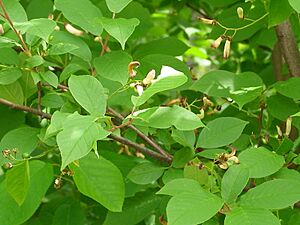
Like many fungi, Taphrina pruni thrives in cool and wet weather. These conditions help the spores to sprout and infect plants. Warm and dry weather, on the other hand, makes it harder for the infection to spread.
Once a plant is infected, the fungus can spread widely, making it very difficult to get rid of. One way to control the disease is to carefully remove any infected branches, witch's brooms, and galls. It's important to do this before the fungus releases its airborne spores.
Some special sprays, called copper-containing fungicides, can also help to control the fungus.


